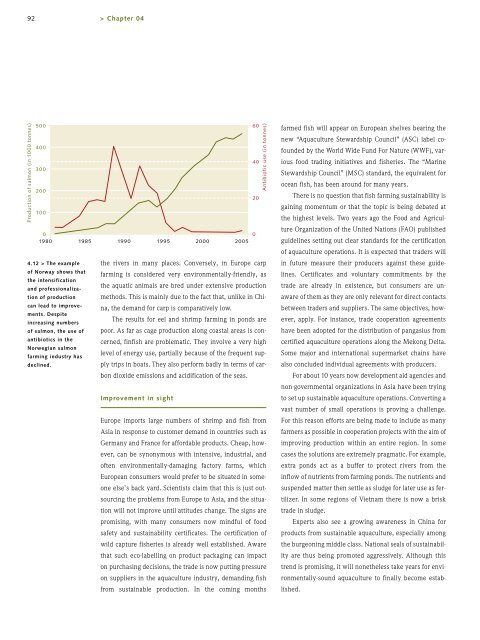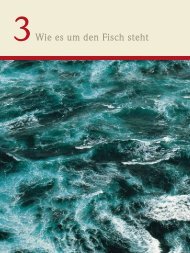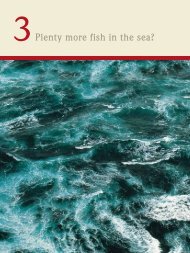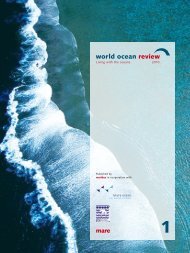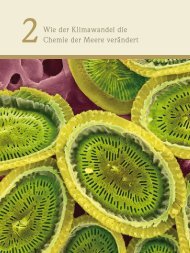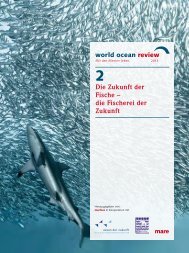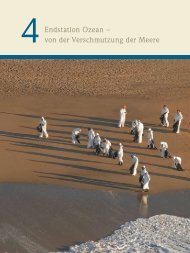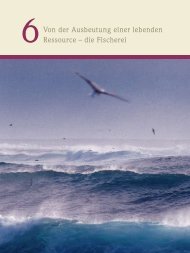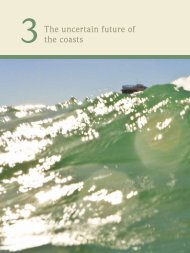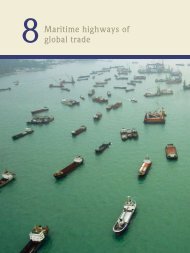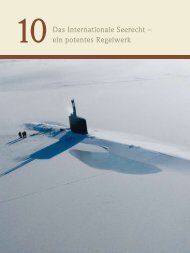Download WOR 2 PDF - World Ocean Review
Download WOR 2 PDF - World Ocean Review
Download WOR 2 PDF - World Ocean Review
Create successful ePaper yourself
Turn your PDF publications into a flip-book with our unique Google optimized e-Paper software.
92> Chapter 04Production of salmon (in 1000 tonnes)500604004030020020100001980 1985 1990 1995 2000 20054.12 > The exampleof Norway shows thatthe intensificationand professionalizationof productioncan lead to improvements.Despiteincreasing numbersof salmon, the use ofantibiotics in theNorwegian salmonfarming industry hasdeclined.the rivers in many places. Conversely, in Europe carpfarming is considered very environmentally-friendly, asthe aquatic animals are bred under extensive productionmethods. This is mainly due to the fact that, unlike in China,the demand for carp is comparatively low.The results for eel and shrimp farming in ponds arepoor. As far as cage production along coastal areas is concerned,finfish are problematic. They involve a very highlevel of energy use, partially because of the frequent supplytrips in boats. They also perform badly in terms of carbondioxide emissions and acidification of the seas.Improvement in sightEurope imports large numbers of shrimp and fish fromAsia in response to customer demand in countries such asGermany and France for affordable products. Cheap, however,can be synonymous with intensive, industrial, andoften environmentally-damaging factory farms, whichEuropean consumers would prefer to be situated in someoneelse’s back yard. Scientists claim that this is just outsourcingthe problems from Europe to Asia, and the situationwill not improve until attitudes change. The signs arepromising, with many consumers now mindful of foodsafety and sustainability certificates. The certification ofwild capture fisheries is already well established. Awarethat such eco-labelling on product packaging can impacton purchasing decisions, the trade is now putting pressureon suppliers in the aquaculture industry, demanding fishfrom sustainable production. In the coming monthsAntibiotic use (in tonnes)farmed fish will appear on European shelves bearing thenew “Aquaculture Stewardship Council” (ASC) label cofoundedby the <strong>World</strong> Wide Fund For Nature (WWF), variousfood trading initiatives and fisheries. The “MarineStewardship Council” (MSC) standard, the equivalent forocean fish, has been around for many years.There is no question that fish farming sustainability isgaining momentum or that the topic is being debated atthe highest levels. Two years ago the Food and AgricultureOrganization of the United Nations (FAO) publishedguidelines setting out clear standards for the certificationof aquaculture operations. It is expected that traders willin future measure their producers against these guidelines.Certificates and voluntary commitments by thetrade are already in existence, but consumers are unawareof them as they are only relevant for direct contactsbetween traders and suppliers. The same objectives, however,apply. For instance, trade cooperation agreementshave been adopted for the distribution of pangasius fromcertified aquaculture operations along the Mekong Delta.Some major and international supermarket chains havealso concluded individual agreements with producers.For about 10 years now development aid agencies andnon-governmental organizations in Asia have been tryingto set up sustainable aquaculture operations. Converting avast number of small operations is proving a challenge.For this reason efforts are being made to include as manyfarmers as possible in cooperation projects with the aim ofimproving production within an entire region. In somecases the solutions are extremely pragmatic. For example,extra ponds act as a buffer to protect rivers from theinflow of nutrients from farming ponds. The nutrients andsuspended matter then settle as sludge for later use as fertilizer.In some regions of Vietnam there is now a brisktrade in sludge.Experts also see a growing awareness in China forproducts from sustainable aquaculture, especially amongthe burgeoning middle class. National seals of sustainabilityare thus being promoted aggressively. Although thistrend is promising, it will nonetheless take years for environmentally-soundaquaculture to finally become established.


